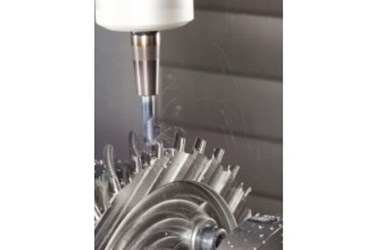Efficient Jet Engine Blade And Blisk Production

Blisk milling requires a high-velocity, multi-axis machine tool, advanced CNC and CAD/CAM software, and efficient milling cutters.
A blisk (bladed disk) is an aeroengine component consisting of a rotor disk and multiple blades in a single part. Replacing the traditional assembly of an individual disk and multiple removable blades, blisks have continued to grow in popularity since their introduction in the mid-1980s. Also known as integrally bladed rotors (IBRs), blisks are usually machined from a solid piece of material.
Using blisks in the compressors and fans of modern turbojet engines improves performance and negates the need to assemble the rotor disk and blades. Vital components can be produced in a single setup on the same machine tool.
Due to their complicated shapes, blisk machining requires the use of multi-axis machine tools and advanced CNC software. Such machining demands effective and reliable cutting tools. Because the majority of blisk machining consists of milling, the quality of the milling cutters is paramount. Usually, blisks are produced from hard-to-cut titanium (Ti) or nickel-based alloys (Ni-alloys), so the milling cutters used need to meet stringent productive and fail-safe machining requirements.
As a major supplier to the aerospace industry, Iscar has developed a wide range of long lasting milling cutters that help guarantee the quality of blisks and boost users’ productivity. For efficient production of blisks, Iscar provides high-quality coated, solid carbide endmills, and MULTI-MASTER tools.
Iscar uses premium submicron and ultra-fine carbide substrates, combined with nano-layer physical vapor deposition (PVD) coating technology and advanced post-coating SUMO TEC treatment, to improve tool impact strength and wear resistance for longer life and enhanced working characteristics.
Blisk milling begins with rough slot milling, so Iscar has developed ECK-M solid carbide endmills with a geometry of reinforced cutting edges to efficiently mill titanium.
If the slot to be milled is deep and narrow, Iscar’s MULTI-MASTER tools provide high-performance characteristics and can be used for milling fillet areas.
MULTI-MASTER end milling tools consist of a shank carrying interchangeable solid carbide cutting heads, threaded to allow a quick-change connection with the shank. The system reduces setup time and can be configured in more than 15,000 ways from standard shanks and heads. If necessary, extensions can be used. Available shank materials include:
- Steel for general-duty applications
- Tungsten carbide with greater rigidity
- Heavy metal for increased vibration resistance
In some blisk rough-slot milling, such as machining Ni-alloys, a trochoidal tool path is the most productive. For this machining method, Iscar developed solid carbide CHATTERFREE endmills EC-H7. Seven flutes with different helix angles enable high stock removal rates.
High-quality surface finish and predictable, long tool life are vital in finish-milling blisks. The cutting tool often works with a high overhang, raising stability requirements. For these situations, Iscar recommends using solid carbide CHATTERFREE tapered ball nose endmills, characterized by different helix angles of the endmill flutes.
Tapered ball nose MULTI-MASTER heads often provide acceptable and economical means.
Productive milling of blisks is based on: a high-velocity multi-axis machine tool, advanced CNC and CAD/CAM software, and efficient milling cutters. Iscar’s cutting tools with new carbide grades and innovative geometries have enabled many global manufacturers of jet engine blades and blisks to achieve considerably reduced cost per unit.
Source: Iscar Metals Inc.
